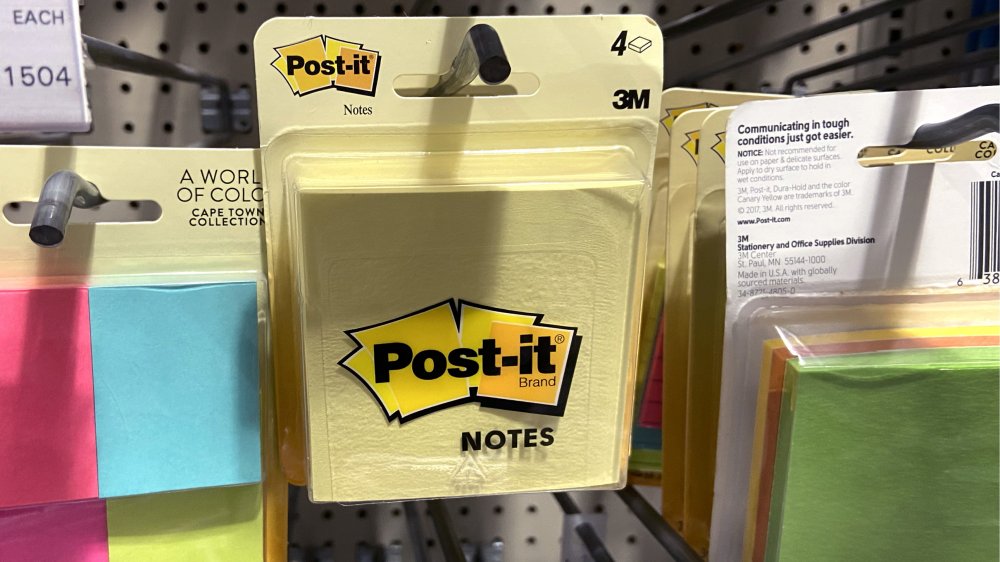The Accident That Led To The Invention Of Post-Its
Some people swear by Post-it notes. They can be found stuck on computer screens, declaring ownership of a stapler, and (per CBS News) they've even been deployed by some intrepid office workers to taunt their neighbors. The humble sticky note has become essential not just for the workplace but also in some homes. When placed somewhere conspicuous like a refrigerator, it's the piece of paper that is hard to ignore. The Post-it note is so popular that it's spawned not just generic versions but also different types. There's Post-it brand bookmarks, book tabs, and flags, especially now that people keep thinking of other uses for them.
Any office worth its salt would stock a lot of Post-its. One might think the Post-it was explicitly invented so people can send increasingly passive-aggressive reminders to each other. But, the Post-it was actually made by accident.
Spencer Silver, a scientist with 3M, was tasked in 1968 with inventing a new adhesive for the manufacturing giant, according to their official website. Silver said he wanted to develop a strong adhesive, but ended up creating one that stuck to things but was still easily removable. He discovered that his glue had microspheres that retain stickiness. Silver couldn't think of a use for his invention; after all, the goal was to find a new adhesive that could stick anywhere. So his microsphere-filled, removable adhesive sat on a shelf for several years as Silver kept looking for a use for it.
The lost bookmark that changed the world
Silver's invention was ignored until 1974, when one of his colleagues hit upon a winning idea. Art Fry, another 3M scientist, was at choir practice when he realized that he'd lost his place in the hymns. He had stuck a couple of pieces of paper inside his hymnbook to mark the songs he was practicing, but they all fell out, CNN reported. Fry thought there must be a product that would stick to the pages without damaging them, so come Sunday, he would know which songs to sing. He remembered Silver talking about microspheres in a seminar and approached the other scientist. He proposed they make a bookmark with a sticky back. Fry spread some of Silver's adhesive on pieces of yellow paper (it was the only ones he could find, apparently) and eureka! A sticky note!
So they tested out the bookmark. Soon, Fry, Silver, and other team members began writing notes to each other on the bookmarks. Fry said that's when they realized the more significant potential of their invention. The paper and the microsphere adhesive was not only useful to mark book pages safely; it was a whole new way of communicating with each other.
Fry and the other scientists brought the idea for sticky notes to 3M management, but, How Stuff Works wrote, executives were skeptical of the product.
Can you imagine a world without Post-its?
They released the notes, marketed as Press' N Peel, to four cities in 1977, but sales were disappointing, explained Stik 2 It, and 3M pulled the product off the shelves. By 1980, however, the notes were once again in stores. 3M had given away samples of the Press' N Peel notes to different offices and soon realized the value of the product. The company rebranded the notes as Post-it and released it nationally. Soon, the Post-it, as we know it today, became a fixture in offices everywhere. Several Fortune 500 CEOs even wrote to 3M to express their undying love for Post-its.
Silver told 3M's website that the Post-it took everyone by surprise because, like most essential items, it was something people thought they didn't need until it was created. 3M noted Post-its are self-marketing, especially when they first hit the shelves — when people stuck them on documents, others would get curious.
Post-it notes are now sold in over 100 countries. They've grown beyond their signature yellow color and can even be customized. There's a variety of sizes, and one line of Post-its uses a heavier, stickier glue. There are digital Post-it notes, as the rise of mobile working increased. (But do those count?) For something that was accidentally invented, Post-its have truly become essential to everyday working life. And to think it could've been a product that sat on a shelf forever — until someone lost their bookmarks for their hymnbook.


